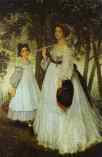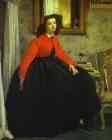Jacques Joseph Tissot (a.k.a. James Tissot) Biography
Jacques Joseph Tissot was born in 1836 in Nantes, France into the family of a merchant. In c. 1856-57 he came to Paris with the desire to become a painter. He entered the Academy of Fine Arts (Ecole des Beaux-Arts) and studied in the studios of Ingres and Flandrin. Much of his education, though, Tissot received informally, through friends and acquaintances among avant-garde artists and writers. Among his influential contacts were Edouard Manet, Edgar Degas, and James McNeill Whistler. The latter evidently had a strong impression on the young artist, shortly after meeting Whistler Tissot anglicized his first name to "James". He was a close friend of Degas; Degas painted an interesting portrait of Tissot. But they later quarreled, and Tissot refused to participate in the Impressionists exhibitions.
Tissot achieved official recognition for his work rather quickly. First he painted historical costume pieces, but in about 1864 he turned to scenes of contemporary life, usually with attractive stylish women. Both the subject and Tissot’s manner of painting had a success with the collectors, and by 1870 the painter was earning a substantial income. In 1870, the Franco-Prussian war started, followed by the civil war, Parisian Commune, in 1871. The government severely suppressed the rising, killing nearly twenty thousand Commune members in the streets of Paris. James Tissot, a Commune sympathizer, had to leave the country to escape imprisonment. He took refuge in London, where he lived from 1871 to 1882.
In England he painted portraits and proceeded with his favorite subject – scenes from the life of society, but adapted to the English tastes, and soon gained a high reputation among the social elite. “It's ironical that the greatest painter of social life in Victorian times was not English, but French – Jacques Joseph Tissot, or James Tissot, as he liked to be known.” (Victorian Painting by Christopher Wood. Bulfinch Press. 2000)
“…during the brief eleven years that he worked in England, achieved both artistic and financial success, painting what are now recognized as his best pictures. The first of his large-scale social scenes was Too Early, exhibited at the Royal Academy in 1873. The painter Louise Jopling, a friend of Tissot, described it as ‘a new departure in art, this witty representation of modern life.’ He followed this with the brilliant Ball on Shipboard of 1874, and Hush, the last of his large pictures of this type, shown at the RA in 1875. No English artist could equal Tissot’s brilliant technique, or his combination of style, elegance and wit, and all three pictures were instantly successful.” (Victorian Painting by Christopher Wood. Bulfinch Press. 2000)
Despite the success Tissot was attacked by most serious critics, including Oscar Wilde, Henry James and Ruskin, who saw in his paintings color photographs of the vulgar nouveaux riches. This contemptuous appraisal did not stop his paintings selling.
About 1876, Tissot met Mrs. Kathleen Newton, a beautiful Irish divorcée, who became his model and mistress. He immortalized her in his paintings Quiet, Chrysanthemums and many others. After her death of tuberculosis, in 1882, he returned to France.
He was no longer interested in painting ‘society’, his emotional state made him retreat into religion. He visited the Holy Land in 1886-87 and in 1889 for careful geographical and ethnographic studies, and made hundreds of watercolor paintings illustrating the Bible. His watercolors on the New Testament were called “a revolution in religious art”. Tissot later made a series of illustrations for the Old Testament as well, but these ones were not as highly appreciated as the earlier ones. Many of Tissot’s Bible watercolors belong to the Brooklyn Museum in Brooklyn, N.Y. Tissot’s biblical illustrations are his most significant work of his last years. He died at Buillon, Department of Doubs, France on August 3, 1902.
Bibliography
James Tissot: Victorian Life / Modern Love by Nancy Rose Marshall, Malcolm Warner; Yale Center for British Art, 1999
James Tissot by James Jacques Joseph Tissot; Phaidon Press and Barbican Art Gallery.
James Tissot by Michael Wentworth; Clarendon Press; 1989.
James Tissot by Krystyna Matyjaszkiewicz (Editor); Abbeville Press, Inc.; 1985.
Victorian Painting by Christopher Wood. Bulfinch Press, 2000.
The Art of the Pre-Raphaelites by Elizabeth Prettejohn. Princeton Univ Pr, 2000.
The Pre-Raphaelites by Christopher Wood. Seven Dials, 2001.
Seductive Surfaces: The Art of Tissot (Studies in British Art, 6) by Katharine Lochnan (Editor). Yale Univ Pr, 1999.
The Albums of James Tissot by Willard E. Misfeldt. Popular Press, 1982.
- Marguerite In Church.

c.1861. Oil on canvas. 50.2 x 75.5 cm. National Gallery of Ireland, Dublin, Ireland. Read Note.
- Two Sisters.

1863. Oil on canvas. 210 x 136 cm. Musée d'Orsay, Paris, France.
- Portrait Of Mlle L.L. (Young Woman In Red Vest).

1864. Oil on canvas. Musée d'Orsay, Paris, France.
- Young Ladies Looking At Japanese Objects.

1869. Oil on canvas. Cincinnati Art Museum, Cincinnati, USA.